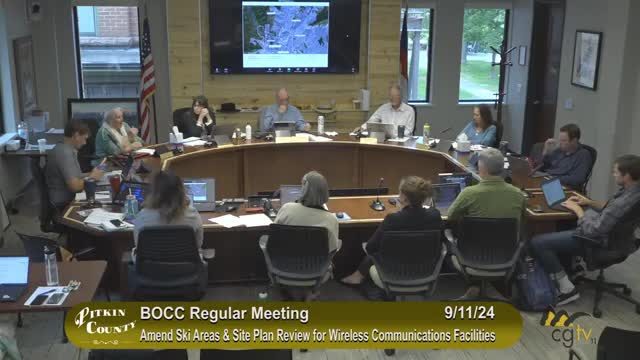Skiing Safety Debate Sparks Controversy Over Cell Coverage
September 11, 2024 | Pitkin County, Colorado
This article was created by AI summarizing key points discussed. AI makes mistakes, so for full details and context, please refer to the video of the full meeting. Please report any errors so we can fix them. Report an error »

In a recent government meeting, officials engaged in a heated discussion regarding the potential installation of cell towers in wilderness areas to enhance emergency response capabilities for skiers and outdoor enthusiasts. The debate highlighted a clash between preserving the natural wilderness experience and the necessity of modern communication technology for safety.
One participant, expressing deep concern, argued against the proliferation of cell phone coverage in the backcountry, stating that it could lead to the degradation of the wilderness experience. Drawing from personal experiences of skiing without a cell phone, they emphasized the importance of disconnecting from technology while enjoying nature. This individual voiced apprehension that reliance on cell phones could alter the dynamics of outdoor activities, transforming them into more industrialized experiences rather than preserving their semi-wilderness character.
In contrast, another official, who has firsthand experience as a first responder, underscored the critical nature of timely communication in emergencies. They pointed out that with the increasing number of skiers and the speed at which they navigate slopes, having cell coverage could be a matter of life and death. The official argued that modern technology could significantly improve response times for accidents, thereby saving lives.
The discussion also touched on the specifics of coverage areas, with questions raised about the effectiveness of proposed towers in remote locations. Officials reviewed mapping data to assess how far the coverage would extend, indicating that while some areas might receive limited service, the overall goal was to enhance safety for all outdoor activities, not just skiing.
Concerns about the health implications of electromagnetic radiation from cell towers were also mentioned, although it was noted that such discussions are often limited by state regulations. Ultimately, the meeting reflected a broader societal debate about balancing technological advancements with the preservation of natural spaces, as officials weighed the benefits of improved safety against the potential impact on the wilderness experience.
One participant, expressing deep concern, argued against the proliferation of cell phone coverage in the backcountry, stating that it could lead to the degradation of the wilderness experience. Drawing from personal experiences of skiing without a cell phone, they emphasized the importance of disconnecting from technology while enjoying nature. This individual voiced apprehension that reliance on cell phones could alter the dynamics of outdoor activities, transforming them into more industrialized experiences rather than preserving their semi-wilderness character.
In contrast, another official, who has firsthand experience as a first responder, underscored the critical nature of timely communication in emergencies. They pointed out that with the increasing number of skiers and the speed at which they navigate slopes, having cell coverage could be a matter of life and death. The official argued that modern technology could significantly improve response times for accidents, thereby saving lives.
The discussion also touched on the specifics of coverage areas, with questions raised about the effectiveness of proposed towers in remote locations. Officials reviewed mapping data to assess how far the coverage would extend, indicating that while some areas might receive limited service, the overall goal was to enhance safety for all outdoor activities, not just skiing.
Concerns about the health implications of electromagnetic radiation from cell towers were also mentioned, although it was noted that such discussions are often limited by state regulations. Ultimately, the meeting reflected a broader societal debate about balancing technological advancements with the preservation of natural spaces, as officials weighed the benefits of improved safety against the potential impact on the wilderness experience.
View full meeting
This article is based on a recent meeting—watch the full video and explore the complete transcript for deeper insights into the discussion.
View full meeting
